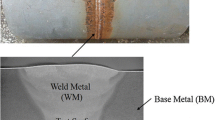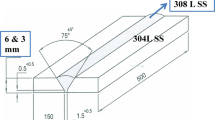Abstract
Due to the importance of the weld metal corrosion, this study aims at the effect of using Ni in weld metals on their corrosion parameters and microstructures. In this regard, the effect of negligible amounts of Ni up to 8.0 wt.% is examined on weld metals made of weld electrodes of the E8018-G type in conditions equal to industrial standards. The corrosion parameters of the weld metals are evaluated through potentiodynamic polarization and electrochemical impedance spectroscopy experiments in a corrosive solution of 3.5% NaCl. The morphology of the weld metals is examined using field emission scanning electron microscopy and optical microscopy. Through evaluating the morphology, corrosion current density (Jcorr), corrosion rate (CR), and polarization resistance (RP) of the weld metals containing different amounts of Ni, it is indicated that Ni plays an important role in creating anti-corrosion properties. The microstructure studies indicate that a weld metal containing 2.91 wt.% Ni is homogeneous, and its major phase is acicular ferrite (AF). The results also show that an optimal amount of 2.91 wt.% Ni in a weld metal provides the highest corrosion resistance in a corrosive solution.








Similar content being viewed by others
References
Davis JR (2006) Corrosion of weldments: 1st ed. ASM international, Cleveland, 44073–0002
Krivonosova EA, Sinkina EA, Gorchakov AI (2013) Effect of the type of electrode coating on the corrosion resistance of weld metal in 08Cr18Ni10Ti steel. Weld Int 27:489–492
Meng Y, Kang K, Gao M, Zeng X (2019) Relationship between corrosion resistance and microstructure characteristic of single-pass laser-arc hybrid welded stainless clad steel plate. Metall Mater Trans A 50:2817–2825
Zhu J, Xu L, Feng Z, Frankel GS, Lu M, Chang W (2016) Galvanic corrosion of a welded joint in 3Cr low alloy pipeline steel. Corros Sci 111:391–403
Ahiale GK, Kim DH, Yang WJ, Lee JH, Oh YJ (2018) Change of precipitation behavior and impact toughness with depths in quenched thick SAF 2507 super duplex stainless steel. Met Mater Int 24:738–745
Zhang Y, Wang S, Ji G. A (2015) A comprehensive survey on particle swarm optimization algorithm and its applications. Math Probl Eng 1-38. https://doi.org/10.1155/2015/931256
Kong KH, Jeon SH, Kim ST, Kim DH, Kim BJ, Guim HU, Moon MB, Park YS (2015) Effects of Cu addition on the microstructure and localized corrosion resistance of hyper duplex stainless steels aged at 748 K. Mater Trans 56:749–754
Melchers RE (2004) Effect of small compositional changes on marine immersion corrosion of low alloy steels. Corros Sci 46:1669–1691
Blekkenhorst F, Ferrari GM, Wekken CJ, IJsseling FP (1986) Development of high strength low alloy steels for marine applications, part 1: results of long term exposure tests on commercially available and experimental steels. Br Corros J 21:163–176
Toppo A, Pujar MG, Arivazhagan B, Vasudevan M, Mallika C, Kamachi Mudali U (2016) Corrosion behaviour of 304LN activated tungsten inert gas and flux-cored arc weld metals. Corros Eng Sci Technol 51:295–307
Rao Bhagavathi L, Chaudhari GP, Nath SK (2011) Mechanical and corrosion behavior of plain low carbon dual-phase steels. Mater Des 32:433–440
Zhang XJ, Gao F, Liu ZY (2017) Effect of Sn on the pitting corrosion behavior of ultra-purified 17% Cr ferritic stainless steel. Steel Res Int 88:1600059–1600071
Gurram M, Adepu K, Pinninti RR, Gankidi MR (2013) Effect of copper and aluminium addition on mechanical properties and corrosion behaviour of AISI 430 ferritic stainless steel gas tungsten arc welds. J Mater Res Techn 2:238–249
Pujar MG, Dayal RK, Gill TPS, Malhotra SN (2005) Evaluation of microstructure and electrochemical corrosion behavior of austenitic 316 stainless steel weld metals with varying chemical compositions. J Mater Eng Perform 14:327–342
Rodrigues CAD, Pagotto JF, Motheo AJ, Tremiliosi-Filho G (2017) The effect of titanium on pitting corrosion resistance of welded supermartensitic stainless steel. Corros Eng Sci Technol 52:141–148
Evans GM, Bailey N (1997) Metallurgy of basic weld metal. Abington Publishing, Cambridge
Kangazian J, Shamanian M, Ashrafi A (2017) Dissimilar welding between SAF 2507 stainless steel and Incoloy 825 Ni-based alloy: the role of microstructure on corrosion behavior of the weld metals. J Manuf Process 29:376–388
Mosallaee M, Hydari J, Ghassemy S, Mashreghee A (2013) Effect of E8010-P1 electrode composition on the weld metal properties. Int J Press Vessel Pip 111:75–81
Tavara SA, Chapetti MD, Otegui JL, Manfredi C (2001) Influence of nickel on the susceptibility to corrosion fatigue of duplex stainless steel welds. Int J Fatigue 23:619–626
Pilhagen J, Sandström R (2014) Influence of nickel on the toughness of lean duplex stainless steel welds. Mater Sci Eng A 602:49–57
Eghbali B, Abdollah-Zadeh A (2007) Deformation-induced ferrite transformation in a low carbon Nb–Ti microalloyed steel. Mater Des 28:1021–1026
Malakondaiah G, Srinivas M, Rao PR (1997) Ultrahigh-strength low-alloy steels with enhanced fracture toughness. Prog Mater Sci 42:209–242
Hanzaei AT, Hoveida-Marashi SP, Ranjbarnodeh E (2018) The effect of hydrogen content and welding conditions on the hydrogen induced cracking of the API X70 steel weld. Int J Hydrog Energy 43:9399–9407
AWS Errata Sheet (1998) American Welding Society, Eight edn. Maiami, Florida
Kou S (2003) Welding metallurgy. Wiley, Hoboken
Zipperian D (2003) Chemical etching. PACE Technologies, Tucson
Hamidon TS, Hussin MH (2020) Susceptibility of hybrid sol-gel (TEOS-APTES) doped with caffeine as potent corrosion protective coatings for mild steel in 3.5 wt.% NaCl. Prog Org Coat 140:105478–105506
Tsao LC, Chen CW (2012) Corrosion characterization of Cu–Sn intermetallics in 3.5 wt.% NaCl solution. Corros Sci 63:393–398
Lee JH, Ahn SH, Kim JG (2005) Effect of Al additions in WC-(Cr1− xAlx) N coatings on the corrosion resistance of coated AISI D2 steel in a deaerated 3.5 wt.% NaCl solution. Surf Coat Technol 190:417–427
Guo N, Liu D, Guo W, Li H, Feng J (2015) Effect of Ni on microstructure and mechanical properties of underwater wet welding joint. Mater Des 77:25–31
Taylor DS, Evans GM (1983) Development of MMA electrodes for offshore fabrication. British Maritime Technology, Metal Construction 15:438–443
Li C, Li JC, Zhao M, Jiang Q (2009) Effect of alloying elements on microstructure and properties of multiprincipal elements high-entropy alloys. J Alloys Compd 475:752–757
Guo H, Liu Y, Li W (2014) Effect of Ni on microstructure, hardness and toughness of medium-carbon low-alloyed steels. Hot Work Techn 43:207–210
Wang W, Mohammadi F, Alfantazi A (2012) Corrosion behaviour of niobium in phosphate buffered saline solutions with different concentrations of bovine serum albumin. Corros Sci 57:11–21
Bard AJ, Faulkner LR (2001) Electrochemical methods: fundamentals and applications, 2nd edn. Wiley, New York
Rahmani S, Omrani A, Hosseini SR (2019) Impact of barium in improving corrosion resistance and properties of electroless Ni–Ba–B alloy deposits. Met Mater Int:1–10. https://doi.org/10.1007/s12540-019-00349-5
Cross CE, Xu P, Winzer N, Bender S, Eliezer D (2011) Corrosion and corrosion-fatigue of AZ31 magnesium weldments. Weld World 55:40–47
Mohammadpour Z, Zare HR (2018) A comparative study on the effect of MWCNT as reinforcement on the corrosion parameters of different Ni–W/MWCNTs nanocomposite coatings in various corrosive media. Met Mater Int 24:761–772
ASTM G102 (2004) Standard practice for calculation of corrosion rates and related information from electrochemical measurements. International, West Conshohocken
Mohammadpour Z, Zare HR (2018) Structural effect of different carbon nanomaterials on the corrosion protection of Ni–W alloy coatings in saline media. New J Chem 42:5425–5432
Clover D, Kinsella B, Pejcic B, De Marco R (2005) The influence of microstructure on the corrosion rate of various carbon steels. J Appl Electrochem 35:139–149
Gilmore DL, Starke EA (1997) Trace element effects on precipitation processes and mechanical properties in an Al-Cu-Li alloy. Metall Mater Trans A 28:1399–1415
Dong CF, Liu ZY, Li XG, Cheng YF (2009) Effects of hydrogen-charging on the susceptibility of X100 pipeline steel to hydrogen-induced cracking. Int J Hydrog Energy 34:9879–9884
Oteyaka MO, Ayrture H (2015) A study on the corrosion behavior in sea water of welds aluminum alloy by shielded metal arc welding, friction stir welding and gas tungsten arc welding. Int J Electrochem Sci 10:8549–8557
Jiang CC, Xiao GY, Zhang X, Zhu RF, Lu YP (2016) Formation and corrosion resistance of a phosphate chemical conversion coating on medium carbon low alloy steel. New J Chem 40:1347–1353
Acknowledgments
The authors wish to thank Yazd Electrode Company for the experimental support of this research.
Author information
Authors and Affiliations
Corresponding author
Additional information
Publisher’s note
Springer Nature remains neutral with regard to jurisdictional claims in published maps and institutional affiliations.
Recommended for publication by Commission X - Structural Performances of Welded Joints - Fracture Avoidance
Rights and permissions
About this article
Cite this article
Fakheri, M., Zare, H.R., Mohammadpour, Z. et al. The impact of Ni on the corrosion behavior and microstructure of weld metal fabricated from E8018-G electrodes. Weld World 64, 1065–1075 (2020). https://doi.org/10.1007/s40194-020-00898-z
Received:
Accepted:
Published:
Issue Date:
DOI: https://doi.org/10.1007/s40194-020-00898-z




